
 |
Recent Books by Forum Members |

 |
 |
|
|
|||||||
 |
|
|
Thread Tools | Display Modes |
|
#286
|
||||
|
||||
|
A rant about tanks just wouldn’t be complete without mentioning some of the tanks that were captured by New Zealanders during WW2.
The following two pictures were taken by George Frederick Kaye on the 26th of July 1944, show the first German Tiger tank to be knocked out by NZ tanks during World War II. It fell to the 18th NZ Armoured Regiment during the advance to Florence, Italy. 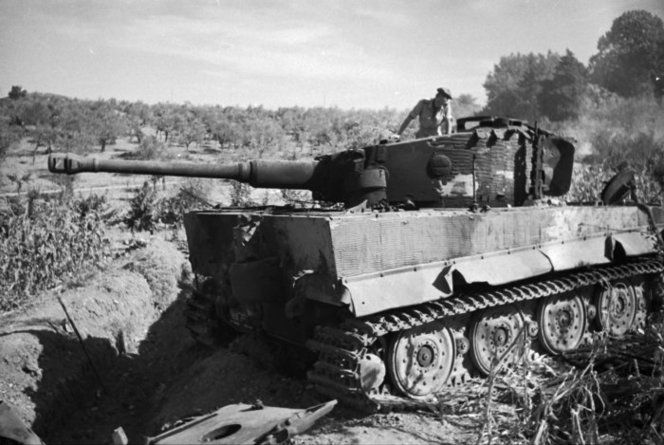  The following picture, also by George Frederick Kaye, was taken on the 21st August 1944. The photo shows F G Dixon (Lower Hutt), J A Brown (Akaura), and L A Trass (Palmerston North) of the 18th New Zealand Armoured Regiment tank recovery crew, posing with a New Zealand Sherman tank after it had been recaptured from the Germans during the advance towards Florence. The Sherman carries the emblems of the German cross, and a white fern leaf in a black square over a red ’80,’which indicates the tank originally belonged to the 19th New Zealand Armoured Regiment. 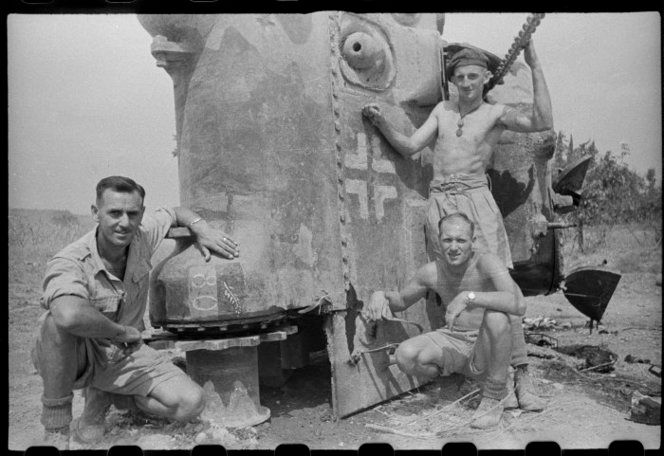 The following youtube footage shows New Zealand tanks in 1942. http://www.youtube.com/watch?v=YAmd5...e_gdata_player Lance Corporal John Lincoln Tucker, 27th (Machine Gun) Battalion Service No. 534207. The following two photographs show two of three German Panther tanks that were captured by Lance Corporal John Lincoln Tucker and members of 14 Platoon, 27th NZ (Machine Gun) Battalion on the 16th April 1945. 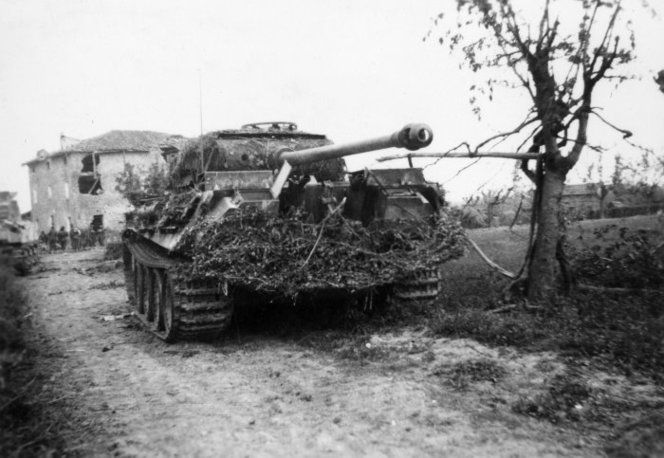  For those who want to know more, the following extract is taken from the Official History of the “27 (Machine Gun) Battalion” by Robin Kay.— (Chapter 24, The Sillaro and Gaiana, page 474) Major Bell describes an encounter with what he is convinced was a Panther tank. ‘Coy HQrs,’ he says, ‘were immediately opposite a barn just passed by 14 pn. I heard the characteristic “whirr” of a tank starting up….’ Private Ness, one of the men with him, says ‘we were close to the road [between 14 and 15 Platoons] where the Panther was making a turn, and one of the crew was visible standing up in the turret…. Major Bell moved towards the road leaving us to follow.’ Bell claims ‘I managed to get in 3—77 [phosphorus] grenades and I am reasonably sure I scored hits.’ The tank made off, followed by Bell and his companions. In a few minutes they encountered some 14 Platoon men, who threw phosphorus grenades at the tank as it passed. ‘When we first heard the staccato whirr and clatter of a track vehicle starting up,’ says Lance-Corporal R. I. Tanner, ‘we thought it may have been a Red Cross Bren carrier coming up to pick up our wounded from the barrage. Our doubts were rudely dispelled when we saw the huge bulk of a Jerry tank, seemingly right on the top of us. It turned abreast of us with its 88 M.M. gun pointing straight at us, and very slowly made to cross a paddock to the road…. ‘We acted very quickly. First thing I remember was Tucker asking me for a Piat bomb…. I suddenly realised with some shame, I had left the bracket of 3 bombs back at the starting point. Tucker immediately suggested phosphorus grenades. All this happened in a matter of seconds…. Tucker, myself and [one or two others] threw our first salvo of 77s…. At least 3 hits were registered on this tank [which Tanner thought was a Tiger] …. The rubber tracks held the phosphorus and we were awestruck at the way it seemingly burst into flames….’ The tank headed towards a house near the crossroads. Tucker reconnoitred towards this house, and on his return Lieutenant Sneddon and McIntyre went forward with him along a hedge and a ditch. Sneddon worked his way round to the left-hand corner of the house, while McIntyre took up a position behind the right-hand corner and Tucker behind a tree. After a few minutes Tucker crept over to McIntyre to tell him that there was a tank on the other side of the road about thirty yards away. By crouching down the two men could see its superstructure silhouetted clearly against the sky. They could also hear German voices. When a man raised himself above the turret, Tucker fired his Tommy gun and McIntyre his rifle. The German screamed and slid back into the hull of the tank. While McIntyre kept up a steady covering fire, Tucker dashed forward along the hedgerow to where a path led from the house to the road. At the gateway he found a second Panther, which previously had been hidden from view by the hedge; it was less than twenty feet from him. He tossed a high-explosive grenade through its open hatch, and also threw a phosphorus grenade at the tank on the other side of the road. Flames immediately shot from the latter, and the crew of four or five rushed from it towards the house. ‘Tucker and I,’ writes McIntyre, ‘went to where I saw them, and came across a dugout. Tucker called on them to come out but getting no response blasted it with HE grenades. It was then that about 8 Italians came out, we questioned them where the Huns were, but they were very hazy about everything. T'was then we heard another tank start up for a getaway. Tucker said to me keep them covered while I have a look. He immediately raced towards the crossroads and attacked it [this was another Panther]…. at the time concentrated Spandau fire was raking the area from a criss cross angle.’ Apparently Tucker's first phosphorus grenade set fire to the rubber on the tank's bogies, for it made off along the lateral road whirling smoke and flame like a Catherine Wheel. By this time 14 Platoon and also 13 Platoon, coming up on the left, had reached a very deep ditch alongside this road. When the tank approached, Walker, who had brought up 13 Platoon's Piat, fired a bomb at it. He says the Panther was ‘only about 30 yds away or less when I fired scoring a hit just below the turret…. Lt Sneddon was knocked out by the blast. He was just behind me and he rolled back down into the ditch.’ The tank continued down the road and disappeared in the dark ness. It was discovered after daybreak in the ditch in front of a house. Sergeant Ward, Tanner and McCoy went to a house on the far side of the crossroads, where they found another tank, probably a Tiger. ‘It seemed to be smoking and appeared to have engine trouble, which led me to believe it had already been attacked,’ writes Tanner. ‘We hit it and it tore off…. It stopped, we made another strike, whereupon it staggered off as we pursued it with the last of our phosphorus grenades. It took a desperate zigzag course across country and eventually burst into a great sheet of flame, where it could be seen next day, a gutted wreck…. ‘We returned to the last house to find Tucker…. He gave me instructions to make a quick search of the outhouses. His last words to me, or anyone else for that matter, were “Dont be more than a minute or two”. So the 3 of us made a quick round while Tucker walked back to the platoon, via the Xroad. In a minute or two we followed. The Jerry's were more active now and several Very light flares caused us to duck as we reached the crossroads. It was here that Sgt Ward noticed a man lying right in the middle of the Xroad. I thought it was just another Jerry, but Ward insisted it was a Kiwi, so by the light of another flare I dragged the body off the road into the roadside ditch.’ Lance Corporal John Lincoln Tucker had been killed by a bullet which had pierced a nail file, his paybook and a notebook. ‘We couldn't believe it. Tucker seemed to lead a charmed life…. It was a very sore point with the men of 14 Platoon that this quiet spoken, dauntless, slim built, unassuming man of few words was not awarded the highest decoration for his unprecedented action in sealing the fate of three of these so called invincible steel monsters and their crews.’ Company Headquarters was established in the house alongside the lane where Tucker had disabled the two Panthers. ‘The C.O. brought down the emergency S.O.S. arty fire on our immediate front and from then on we had no further enemy activity from that direction,’ says Bell. ‘However a casa on our extreme left … was pestering us with sporadic spandau fire. … Lieut. Hayes, of 13 pn, took a recce patrol to investigate this enemy position. He reported back in due course that he considered it very strongly held.’ Men from 14 and 13 Platoons attacked two spandaus dug in under haystacks near the house in front of which the Panther had gone into the deep ditch. Lance-Sergeant Burton remembers ‘using up all the H.E. grenades we had between us, in order to silence the two “spandaus”…. It was very open ground, and it was a matter of wriggle on one's stomach to within grenade range, as the intermittent fire from Jerry was only inches above the hair on the back of one's neck. It was so dark at that hour that all you could see from ground level was the outline of the haystacks and the house behind.’ At dawn about twenty-five prisoners were taken from the house without much opposition. Bell had been unable to make contact with Lieutenant Smith (15 Platoon) on the right flank. ‘This at the time was most disturbing as I was being asked by 2 Coy [which was following 3] for the “O.K.” to piat a casa somewhere on their right flank. I could not possibly give such an O.K. as Smith would be some where in the locality. Some time afterwards Sgt Ward did a good job in locating this pn.’ It had met little opposition and had pushed on to the objective and dug in, but Smith had been separated from his wireless set and unable to report his position. The company's casualties had been remarkably few: one killed and six wounded; on the other hand it had accounted for many Germans, and had captured three tanks and destroyed a fourth. Last edited by atillathenunns; 15-08-13 at 10:36 AM. |
|
#287
|
||||
|
||||
|
For those who haven’t realised ( post #254) old Atilla is primarily a Military hat collector, with a passion for New Zealand headdress. So to finish off my tank ramble before I return to the subject of New Zealand machine guns and badges, I would like to share some pictures of a NZ Black tankers beret in my collection.
Probably the two most famous Black tankers berets, is the one that was presented by Sergeant Jock Fraser of B Squadron, 6th Royal Tank Regiment to General Bernard Montgomery, followed by the Black tankers beret that was worn by the King who was Colonel-in-Chief of the Royal Tank Corps. Prior to the black beret being presented to Monty, for a short period, he famously wore an Australian slouch hat (with a N.Z.E.F. onward badge at the front), which was given to him on the 14th August 1942, by the HQ of the Australian 24th Infantry Brigade. Montgomery's slouch hat is now in the Australian War Memorial collection in Canberra. Before the Battle of El Alamein (25th October 1942) General Montgomery addressed the New Zealand Division, and interestingly, he was wearing his “famous black beret, with an N.Z.E.F. badge on one side.” “He told the Kiwis how they would go into battle shoulder to shoulder with Australians, Indians. South Africans and soldiers of famous English regiments, with powerful units of the R.A.F. and South African Air Force overhead. United they would crush Rommel and his forces.” (Field Marshal Bernard Montgomery donated his famous black beret to The Tank Museum in 1945) My “old desert worn beret” is not famous like Monty’s desert beret, but as far as New Zealand black berets go, it’s as close to a holy grail relic that a kiwi collector can hope for. This beret belonged to Lieutenant-Colonel T. C. Wallace, Commanding Officer of the 2nd NZ Tank Battalion (Waiouru), and Commanding Officer of the Special Army Tank Squadron 2NZEFIP.  As a Captain, Wallace had commanded the Headquarters Squadron of the 4th Waikato Mounted Rifles 2NZEF. Prior to Wallace’s transfer to Waiouru New Zealand, it appears he completed intensive courses in several branches of tank training at the Middle East Royal Armoured Corps School. So uniquely, this NZ tankers beret was worn in both the desert and the Pacific. The New Zealand Army Tank Brigade was formed on the 7th September 1941, when 72 officers and men of the Divisional Cavalry Regiment 2NZEF arrived at Waiouru military camp. (majority of which were trained at the Middle East Royal Armoured Corps School) The New Zealand Army Fighting Vehicles (AFV) School was established at Waiouru military camp on the 18th September 1941. Initially, only the instructors and members of the staff of the Armoured Fighting Vehicles School wore the black beret, and on the right upper arm a worsted badge of a white tank outlined in black. On the 16th October 1941, the arrival of the several thousand men drafted into the Tank Brigade arrived at Waiouru and were divided into three battalions, (representing the 3 military districts). Members of the tank brigade were first issued the standard battle dress and the field service cap, and shortly after were issued with a black puggaree for the Lemon Squeezer hat. Official approval to wear the black beret was granted in Regimental Orders on the 17th February 1942. The New Zealand Army Tank Brigade were the only unit within New Zealand authorised to wear the 2NZEF Onward badge.  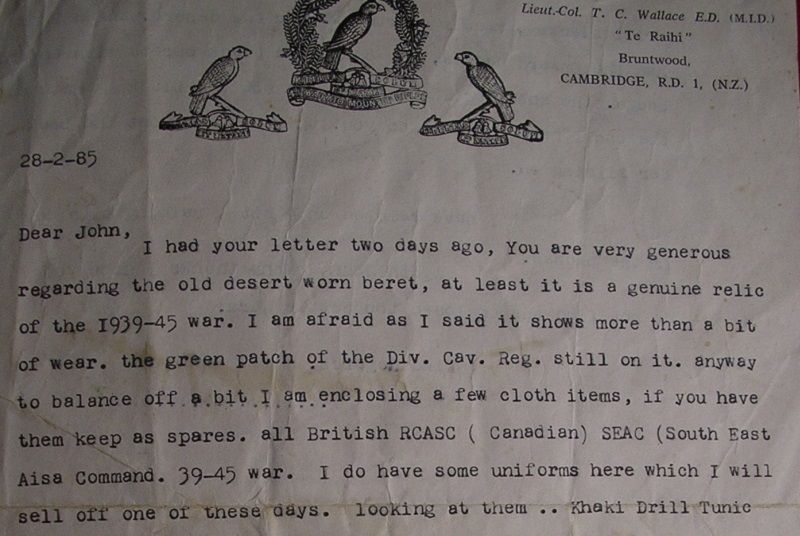  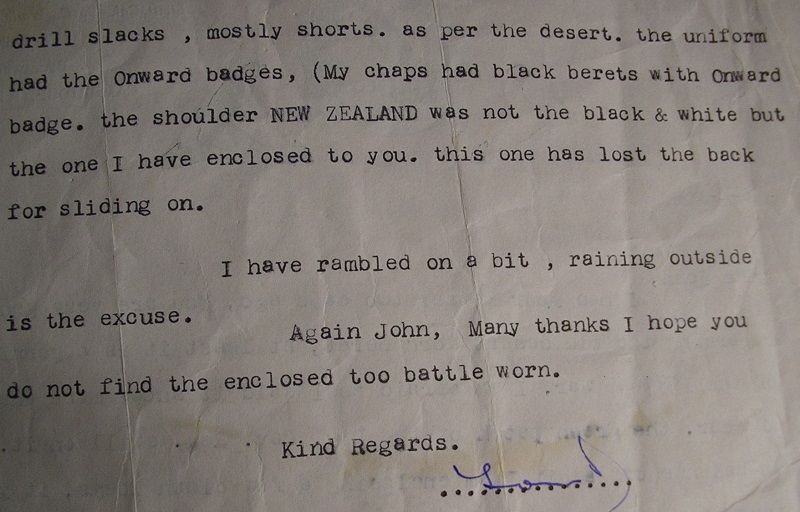
|
|
#288
|
||||
|
||||
|
In post #208, I mentioned that the design of the crossed machine guns of the following - New Zealand Specialist Company Machine Gun Section reinforcements cap badge, were based on a Maxim machine gun.
My reasoning was that the crank handle on the left gun was more similar to the Maxim, than it was to the Vickers machine gun, and this feature was only found on NZMGS reinforcement badges. 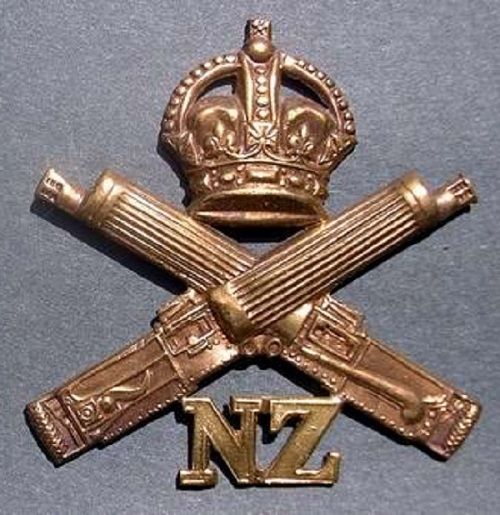 In post # 211, Richard Fisher corrected me and said that the badge is undoubtedly a Vickers machine gun, his reasoning was that except for the crank handle, the rest of the gun was definitely all Vickers. Although a Vickers machine gun is fundamentally a modernised Maxim machine gun, the following Royal Naval Division crossed machine gun badge, proves that the crank handle is not just unique to the NZMGS badge, and that Richard is correct, that the NZMGS crossed machine gun badge is a Vickers machine gun. 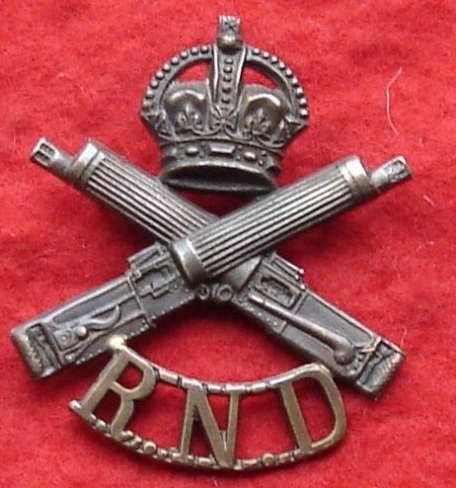 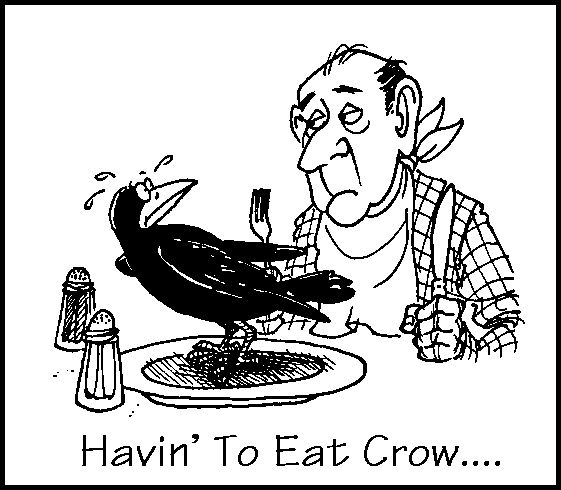
|
|
#289
|
||||
|
||||
|
Moved to post 384 to 387.
Last edited by atillathenunns; 28-07-14 at 09:19 AM. |
|
#290
|
||||
|
||||
|
Moved to post 384 to 387.
Last edited by atillathenunns; 28-07-14 at 09:19 AM. |
|
#291
|
|||
|
|||
|
Quote:
Regards Richard
__________________
Vickers MG Collection & Research Association, a not-for-profit company, limited by guarantee, registered in England, Company Registration Number 07855202 - www.vickersmachinegun.org.uk |
|
#292
|
||||
|
||||
|
Quote:
Oddly, I had suspected the NZ Reinforcements Machine Gun badge origins lay with the MMG badge, but my own searches of typing Motor Machine Gun badge into the Google browser and hitting ‘images’ have failed to find any matches, although the very first badge that shows up, does look similar but is not a match. Is this the badge you are referring to, or better still, do you have a photo of an MMG badge that matches the NZMGS badge? On the other hand, if you type “Royal Naval Division machine gun badge” into the Google browser and hit images, there is another example of this rare variation of machine gun badge. Regards Brent |
|
#293
|
||||
|
||||
|
In case it's of any use I have attached a photo of my two for a comparison, the MMG was in amongst some family ww1 stuff.
Cheers Corey |
|
#294
|
||||
|
||||
|
Cheers Corey, but your MMG is the more common variation. I have found another one in a British thread, which is just the crossed Vickers (no rocker), and it seems to be a rare variation and considered to be an early pattern.
However I am leaning towards it being just a rare variation until one with a MMG rocker turns up, as at the end of the day, the MMG were the first to use the crossed machine guns. Cheers Brent 
Last edited by atillathenunns; 08-10-13 at 11:40 AM. |
|
#295
|
||||
|
||||
|
Brent ,wasn't the green diamond patch a post war Div Cav one?
Quote:
|
|
#296
|
||||
|
||||
|
Trooper Andrew Sutherland,(my wife's great uncle) ,20th Armoured Brigade .Served on Crete ,where he was reported missing ,later turned up in Egypt after the debacle .Served in Egypt and was the Divisional shot put champion .Later served as a guard at Divisional Headquarters .
A beret the same as Andrew is wearing in the photo. An Onward badge backed with red felt Last edited by pukman; 09-10-13 at 08:04 AM. |
|
#297
|
||||
|
||||
|
Iain that is not quite correct, according to NZ Divisional Cavalry Regimental order 85 (dated 17th February 1943), it states that green colour patches were being worn (unofficially) that extended outside the edges of the onward hat badge.
Colonel Wallace was a Commanding officer of a NZ Tank battalion, as such he was in a position to bend the rules slightly when it came to his own insignia, this can be seen on page 66 of the NZ patch book, which shows the actual shoulder insignia worn by Colonel Wallace in the Pacific, whereas the actual shoulder insignia worn by his men was a black ‘New Zealand’ on a khaki background. (Shoulder titles worn by his men is mentioned in his letter) The patch on Wallace’s beret is unique, it is bigger than the 2 inch square rifle green patch adopted by the Royal New Zealand Armoured Corps, it also has no extra badge holes, and the post war RNZAC badge does fit as its lugs are slightly wider. At the end of the day, it is this little sentence that is what is important – “The old desert worn beret, at least it is a genuine relic of the 1939-45 war. I am afraid as I said it shows more than a bit of wear. The green patch of the Div. Cav. Reg. still on it.” 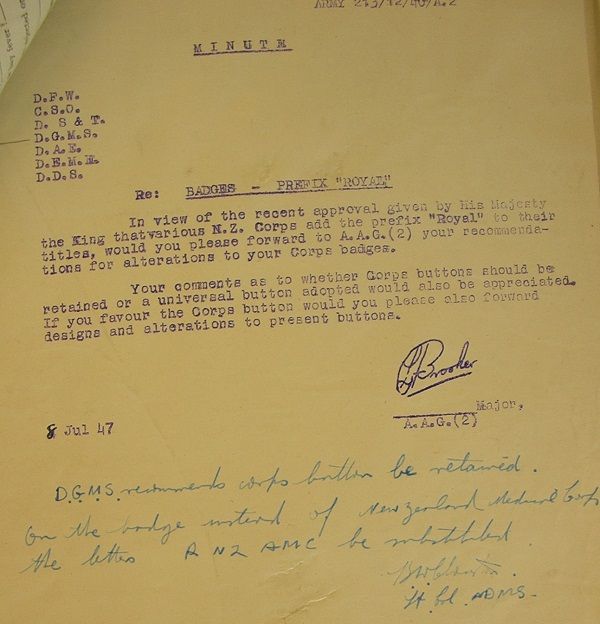 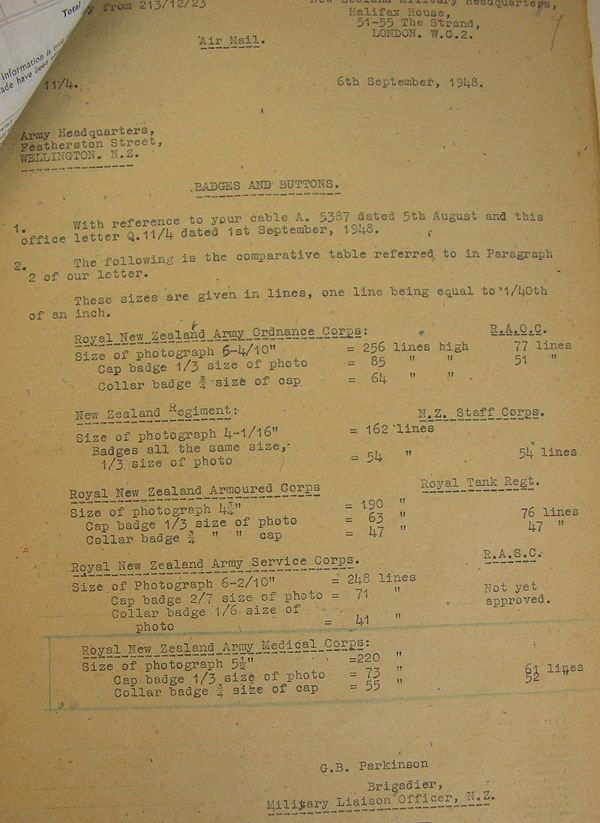 On a side note, I have a bit of an update on post # 277 in which I mentioned – “The Second Battle of Bapaume (21 August - 3 September 1918) was part of the second phase of the Battle of Amiens. Schnuck was one of two German tanks to be captured in the Fremicourt area, the second tank No. 528 named Hagen was captured by British troops.” On Sunday was the October meeting of the Wellington Antique Arms, as the display theme was the letters M & N, I put on a display of NZ Machine gun badges. Also at the meeting was Peter Cooke who has written some pretty decent books, and after a bit of a chat about the WW1 tank Schnuck, I purchased his latest book “Great Guns, The Artillery Heritage of New Zealand,” for a discount price of $40. The book which was well worth the price has four pages of information regarding the German tanks Schnuck and Hagen, and it is clear from the information supplied that it was not British troops that captured Hagen (No.528), but instead Hagen was captured by the Auckland Infantry Battalion. (Schnuck was captured by the 1st Wellington Infantry Battalion). So it seems that New Zealand captured 20% of the A7V tanks built by Germany. Hagen was to be transported to New Zealand as a war trophy, unfortunately due to “difficulties of transport” (and other errors) Hagen and Schnuck were left to War Office to dispose of them as they saw fit. |
|
#298
|
||||
|
||||
|
Brent,
Nice beret .Only going by what I have been reliably informed ,which is ,the Onward badge on the WW2 black beret is backed by green felt ,whereas the post war , Div Cav black beret has a green diamond patch . I will ask around Iain I've had to borrow this image from another site as I don't own a WW2 Div Cav beret .It's certainly on the wish list !!! Last edited by pukman; 10-10-13 at 12:15 AM. |
|
#299
|
||||
|
||||
|
Some tank lids from my collection
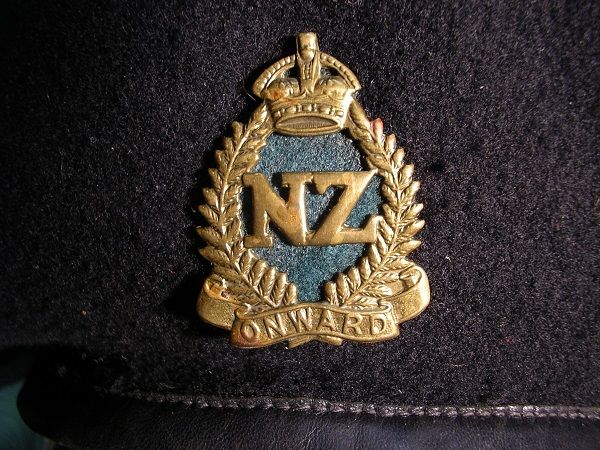 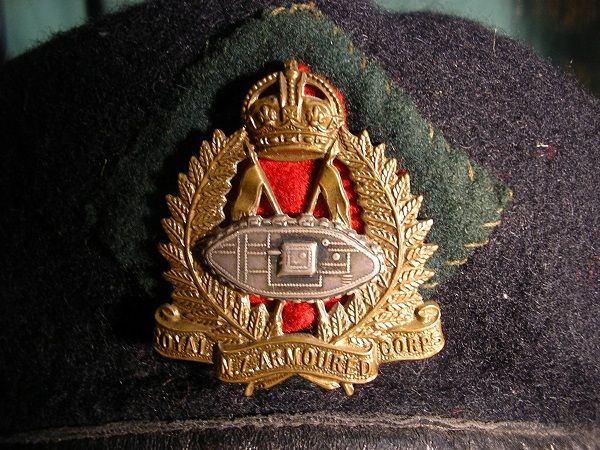 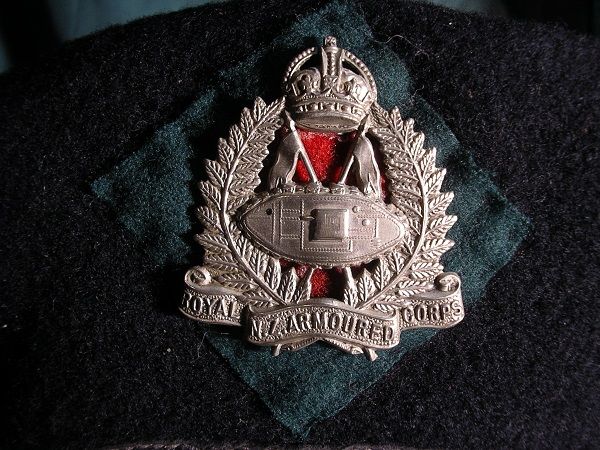 Note that the 2 inch green wool patches on the RNZAC berets are very different from the patch on Wallace’s beret. |
|
#300
|
||||
|
||||
|
Don't shoot the messenger, only passing on information from two of NZ's leading authorities in uniforms and insignia ,They think your beret is post war
|
 |
|
|
 |